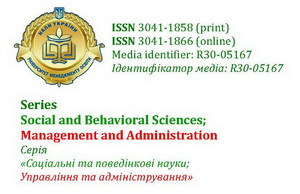Social adaptation problem of a child with early childhood autism
Abstract
The article focuses on the social adaptation problem of children suffering from early childhood autism (ECA) and experiencing delays in the development of all mental processes due to the syndrome. At the beginning of the article, the reader is introduced to a discussion of research conducted by scientists from the past century who worked on this issue. These researchers accurately identified the diagnostic methods and psychological characteristics of children with ECA syndrome. They classified such children as belonging to an atypical category, citing disruptions in their personality structure and emotional-volitional sphere caused by ECA syndrome. Nevertheless, the scientists also noted that some of the mental functions in these children are isolated, yet remain "operational." The article highlights the findings from observations that revealed the impact of pathology on the behavior and speech of children with ECA syndrome. Scientists emphasized that these children exhibit asynchronous development in speech and other mental functions.Independenceand autonomy in their behavior and speech are retained for an extended period. In other words, it is impossible to observe conscious behavior or speech in a child suffering from ECA syndrome. The importance of involving such children in psychocorrectional measures is particularly emphasized in the article. In the methodology section of the article, it is recommended that specialists or parents pay more attention to certain characteristics considered essential in children with ECA syndrome. These specific traits are the primary factors causing social adaptation problems in autistic children. For this reason, we decided to implement our psychocorrection methods using diagnostic techniques. While applying these diagnostic methods, we focused on three parameters of the autistic child's behavior and speech characteristics. These characteristics were assessed using a scoring system. Based on the results obtained, we concluded that the primary goal when working with a child suffering from ECA through psychopedagogical correction methods should be to develop both cognitive activity and social adaptation in the child. Therefore, psychopedagogical correction work for the social adaptation of a child with ECA was designed based on 12 criteria, and the desired outcome was achieved. In autism, individuals avoid human contact and do not emotionally differentiate between inanimate and animate objects, showing a preference for inanimate objects and rejecting living beings. They exhibit emotional resonance to surrounding situations yet display indifference and coldness even toward their close ones. Along with these traits, they also exhibit a high degree of fear and sensitivity to loud sounds. Characteristic sensory stimuli such as tactile, temperature, light and sound are unpleasant and traumatizing for these children. Consequently, stimuli that are acceptable for a normal healthy child become sources of emotional discomfort for an autistic child. The strongest stimulus for an autistic child is the human face. Autistic fears distort their perception of the material world. Research has shown that these children do not perceive objects in their environment as a whole but rather based on separate affective features.
Keywords
Full Text:
PDFReferences
REFERENCES / СПИСОК ВИКОРИСТАНИХ ДЖЕРЕЛ
Azərbaycan Respublikasının Prezidenti. (2013, Oktyabr 24). Azərbaycan Respublikasında təhsilin inkişafı üzrə Dövlət Strategiyası. [Online]. Available: https://president.az/az/articles/view/9779
Ə. S. Bayramov, Ə. Ə. Əlizadə, Psixologiya. Bakı, Azərbaycan: Çinar, 2002. [Online]. Available: https://adpuquba.edu.az/wp-content/uploads/2020/12/Psixologiya-Ali-mektebler-ucun-derslik-BAYRAMOV.pdf Application date: November 25, 2024.
E. İ. Şəfiyeva, Anomal inkişafın psixologiyası. Bakı, Azərbaycan: ADPU nəşriyyatı, 2012. [Online]. Available: https://www.scribd.com/document/750423375/Prof-E-%C4%B0-%C5%9E%C9%99fiyeva-Anomal-inki%C5%9Faf%C4%B1n-psixologiyas%C4%B1-az Application date: November 25, 2024.
M. Ə. Məmmədova, Xüsusi qayğiya ehtiyaci olan uşaqlarla psixokorreksiya işinin təşkili. Bakı, Azərbaycan: ADPU, 2016.
L. V. Kuznetsova, General issues of special psychology. Mental development in asynchronies. Moscow, Russia: "Academy", 2002. (російською).
K. S. Lebedinskaya, О. S. Nikolskaya, Diagnostics of early childhood autism. Moscow, Russia: Education, 1991. (російською).
N. I. Ліфінцева, Fundamentals of correctional and pedagogical work with children with developmental disabilities. Fundamentals of correctional pedagogy. Moscow, Russia: "Academy", 2016. (російською).
L. S. Vygotsky, Collected works: In 6 volumes. T.3. Problems of mental development. Moscow, Russia: Pedagogy, 1983, р. 273-291. (російською).
K. Guldberg, R. Bradley, K. Wittemeyer, Good Autism Practice Report. Full Report. [Online]. Available: https://www.autismeducationtrust.org.uk/sites/default/files/2021-09/GAP_report%20-%20mainReport_I-S.pdf Application date: November 25, 2024.
N. M. Nazarova, Special pedagogy. Moscow, Russia: "Academy", 2000. (російською).
V. М. Astapov, Yu. V. Mikadze, Psychology of children with mental development disorders and deviations. St. Petersburg, Russia, 2008. (російською).
Аzərbaycan Respublikasinin Qanunu. (2009, İyun 19). «Təhsil haqqında qanunu, № 833-IIIQ». [Online]. Available: https://e-qanun.az/framework/18343
TRANSLATED AND TRANSLITERATED / ПЕРЕКЛАД, ТРАНСЛІТЕРАЦІЯ
President of the Republic of Azerbaijan. (2013, October 24). State Strategy for the Development of Education in the Republic of Azerbaijan. [Online]. Available: https://president.az/az/articles/view/9779 (in Azerbaijani).
A. S. Bayramov, A. A. Alizadeh, Psychology. Baku, Azerbaijan: Chinar, 2002. [Online]. Available: https://adpuquba.edu.az/wp-content/uploads/2020/12/Psixologiya-Ali-mektebler-ucun-derslik-BAYRAMOV.pdf Application date: November 25, 2024. (in Azerbaijani).
E. I. Shafiyeva, Psychology of Anomalous Development. Baku, Azerbaijan: ADPU Publishing House, 2012. [Online]. Available:https://www.scribd.com/document/750423375/Prof-E-%C4%B0-%C5%9E%C9%99fiyeva-Anomal-inki%C5%9Faf%C4%B1n-psixologiyas%C4%B1-az Application date: November 25, 2024. (in Azerbaijani).
M. A. Mammadova, Organization of psychocorrectional work with children in need of special care. Baku, Azerbaijan: ADPU, 2016. (in Azerbaijani).
L. V. Kuznetsova, General issues of special psychology. Mental development in asynchronies. Moscow, Russia: "Academy", 2002. (in Russian).
K. S. Lebedinskaya, О. S. Nikolskaya, Diagnostics of early childhood autism. Moscow, Russia: Education, 1991. (in Russian).
N. I. Ліфінцева, Fundamentals of correctional and pedagogical work with children with developmental disabilities. Fundamentals of correctional pedagogy. Moscow, Russia: "Academy", 2016. (in Russian).
L. S. Vygotsky, Collected works: In 6 volumes. T.3. Problems of mental development. Moscow, Russia: Pedagogy, 1983, р. 273-291. (in Russian).
K. Guldberg, R. Bradley, K. Wittemeyer, Good Autism Practice Report. Full Report. [Online]. Available: https://www.autismeducationtrust.org.uk/sites/default/files/2021-09/GAP_report%20-%20mainReport_I-S.pdf Application date: November 25, 2024. (in English).
N. M. Nazarova, Special pedagogy. Moscow, Russia: "Academy", 2000. (in Russian).
V. М. Astapov, Yu. V. Mikadze, Psychology of children with mental development disorders and deviations. St. Petersburg, Russia, 2008. (in Russian).
Аzərbaycan Respublikasinin Qanunu. (2009, İyun 19). «Təhsil haqqında qanunu, № 833-IIIQ». [Online]. Available: https://e-qanun.az/framework/18343 (in Azerbaijani).
Refbacks
- There are currently no refbacks.
